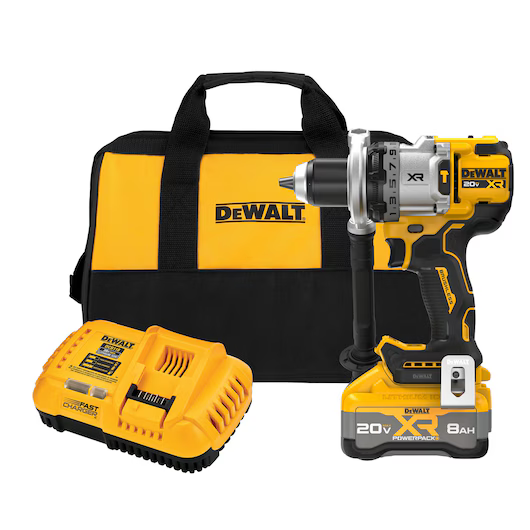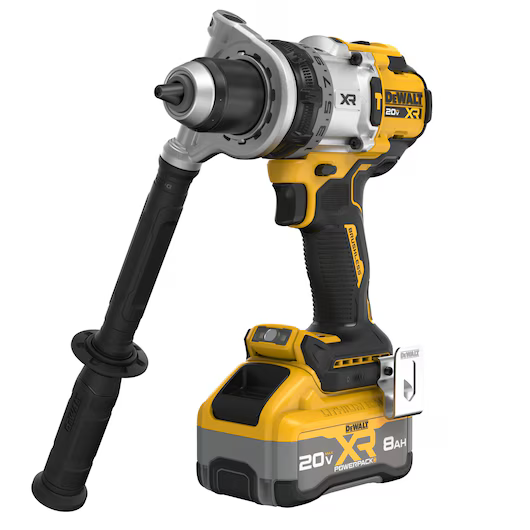Auger Drill Power: How Much Do I Need?
This guide simplifies selecting the right drill for planting with your Power Planter auger, which is essential for successful drilling tasks such as gardening or fence installation. It tackles the challenge of navigating the diverse drill market by highlighting key considerations like power specs and performance features. Additionally, it explains how a drill's intended use—whether everyday, heavy-duty, or professional—affects its compatibility with various tasks. You'll learn how to best choose a power drill auger setup that complements your Power Planter auger, project needs, and soil conditions for efficient digging.
Selecting the Right Drill: Types, Voltage, and Performance
When choosing an auger drill, it is essential to understand the relationship between drill types, their voltage ranges, and performance capabilities. Drills can be broadly categorized into everyday use, medium/heavy-duty, and professional, each suited to different tasks based on their power (voltage) and performance features. Knowing which category your garden drill falls into is one of the simplest ways to determine whether or not it will work with your auger.
Everyday Use Drills (12V - 14V):
Characteristics: These drills are lightweight, compact, and designed for ease of use. They are perfect for light-duty tasks such as drilling small holes, driving screws, and light gardening work (i.e., a few small 3” or less holes). We do not recommend anything larger than our 2” x 7” or 3” x 7” Augers for these drills.
Performance: They operate at lower voltages, making them unsuitable for heavy auger work but ideal for precision tasks and light materials. They are great for projects that prioritize budget and convenience over power.
Recommended For: Home DIY projects, light gardening tasks, assembling furniture, and other activities that demand minimal to moderate power. A compact drill for auger bits can work well for these small-scale applications.
Medium/Heavy-Duty Drills (18V - 20V):
Characteristics: A step up in power and durability, these drills offer a balance between performance and manageability. They are equipped to handle more demanding tasks that require additional torque and endurance.
Performance: These drills provide the versatility needed for a range of applications, from drilling in soft soil to powering through tougher garden landscapes. Many DIY enthusiasts and professionals consider them the best drill for garden augers when tackling a wide array of tasks.
Recommended For: Medium-scale gardening and landscaping tasks, drilling into harder soils, driving large screws, and medium-sized auger applications. Models with all-metal chucks and a side handle work with auger drill bits up to 5” in diameter for home gardening use.
Professional Drills (36V to 60V):
Characteristics: Designed for the most demanding tasks, professional drills offer the highest torque and power. These drills are built to withstand rigorous, daily use on construction sites and in large-scale landscaping projects.
Performance: High-voltage models (36V to 60V) are capable of driving large augers through hard, compacted soils or cutting through roots without straining the motor. They feature advanced settings and brushless motors for enhanced efficiency and durability. Many include a built-in clutch, which will shut the unit down when too much resistance is met, preventing injury to the user.
Recommended For: Heavy-duty construction work, professional landscaping projects, large-scale installations, and any task requiring continuous, high power. A 60V drill for garden auger setup is ideal for handling drill auger attachments up to 9” in diameter.
The length and the diameter of our augers increase the weight of the tool itself as well as the volume of soil being moved. Therefore, a more powerful drill is required the deeper and wider you need to drill into the ground. The chart below shows the minimum suggested drill voltage requirements for various hole sizes and depths, which will help you determine the appropriate diameter auger for your next project.
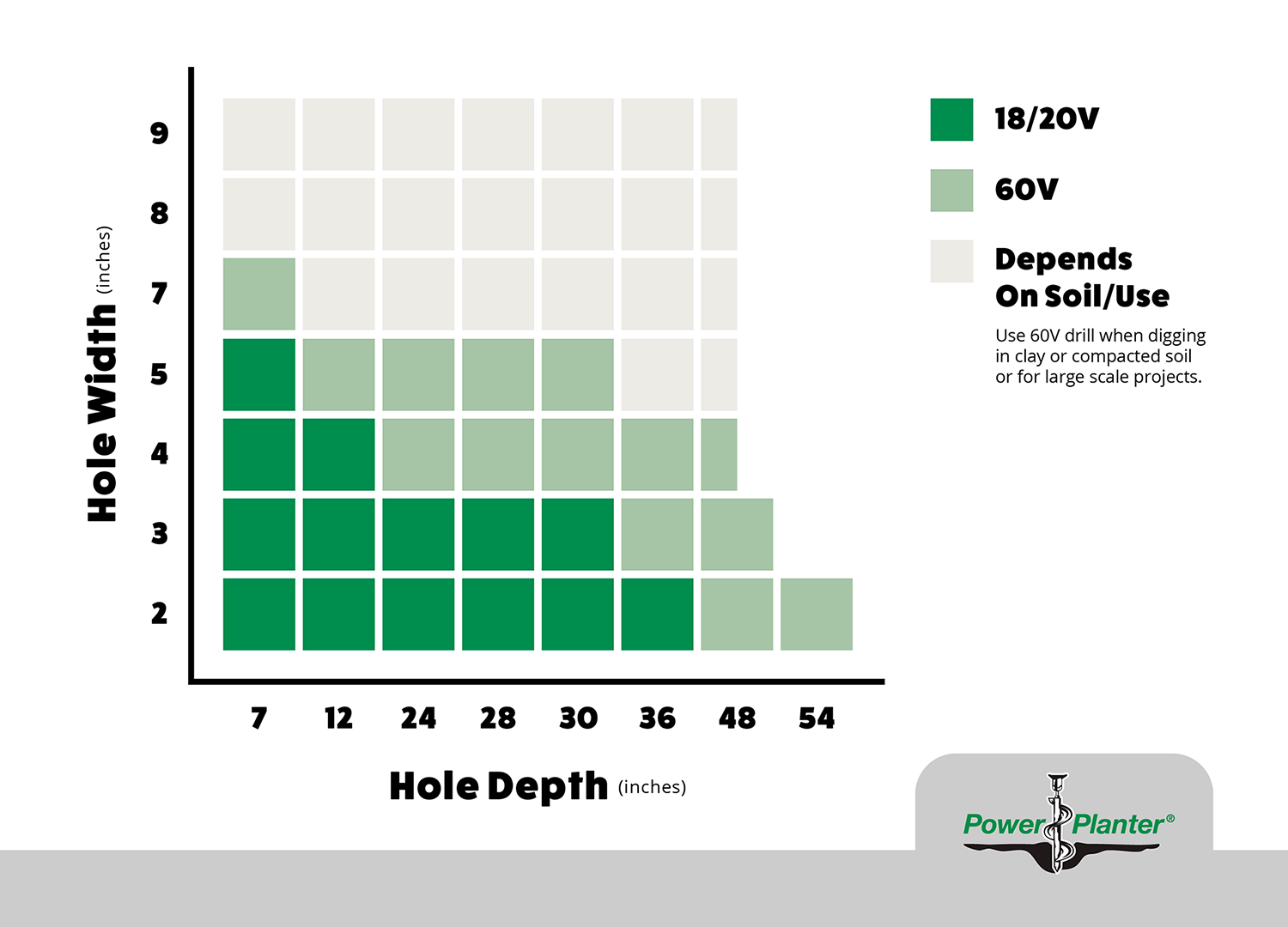
Power Requirements by Diameter
2″ Diameter
- Minimum power requirement for 7” length = 14V cordless drill. Hard compacted soil may require 18V or more.
- Minimum power requirement for 24” or greater length = 18V – 20V cordless drill.
3“ Diameter
- Minimum power requirement for 7” length = 14V cordless drill. Hard compacted soil may require 18V or more
- Minimum power requirement for 24” or greater length = 18V – 20V
7“ Diameter
- We recommend using a 60V cordless drill with this diameter.
8“ & 9“ Diameter
- We recommend using a 60V cordless drill with this diameter.
Additional Tips
- For mass planting, use a cordless drill with a side handle for added support.
- Longer auger lengths tend to benefit from higher voltage power drills.
- See important safety tips below.
Drill Chuck Sizes and the Importance of Torque
If you’re unsure about how to categorize your drill based on voltage, consider the chuck sizes your drill uses.
In selecting the ideal drill for your Power Planter auger, understanding the significance of drill chuck sizes becomes paramount. The chuck size directly correlates with the maximum size of the drill bit it can accommodate, which is crucial for ensuring your drill can securely hold and effectively use the auger bit.
1/4-inch Chuck: Sufficient for light-duty drill drivers, this chuck size is best suited for simple tasks that require minimal torque. Does NOT work with any Power Planter augers.
3/8-inch Chuck: This is the versatile middle ground, accepting a wide array of bit sizes. It's perfect for the majority of home gardening tasks with your Power Planter auger, where a balance between power and manageability is needed. This size drill will work with our 2” x 7”, 3” x 7”, and 3” x 12” augers. Drills in this category are generally not very rugged, but are made for everyday use in and out of the house.
1/2-inch Chuck: For heavier or more constant applications requiring maximum torque, this chuck size is ideal. It accommodates larger bit sizes, making it suitable for demanding drilling tasks in tougher soil conditions. This chuck size is also becoming the standard bearer of most drills sold in the marketplace.
Prioritizing Torque Over Speed:
When working with soil, the need for high torque and comfortable handling outweighs the requirement for high RPMs. A variable-speed garden drill with an adjustable clutch offers the versatility needed for drilling different materials, ensuring you have control over the drill's power and can prevent damage to the auger or the workpiece. This adjustability is vital for matching the drill's performance to the task at hand, especially in varied soil types or when encountering underground obstacles.
Efficiency with Keyless Chucks:
Modern drills often feature keyless chucks, which allow for quick and easy bit changes without the need for additional tools. This feature is particularly beneficial when switching between different sizes of auger bits, streamlining the process and enhancing efficiency.
Soil Types and Their Impact
Once you know what voltage and chuck sizes work best with your auger, the other factor in determining what type of drill for planting you need is the type of soil. Different-density soils will need different torques to dig through the ground safely.
Clay Soil
Dense and heavy, clay soil requires a drill with high torque to push through the resistance. A heavy-duty or professional drill, preferably with a low RPM and high torque setting, is ideal for managing the challenging nature of clay.
Sandy Soil
While easier to drill through than clay, sandy soil can cause wear on the drill and auger bit due to its abrasive nature. An auger drill with variable speed settings can help manage the balance between speed and control, preventing the auger from becoming bogged down.
Loamy Soil
This soil type is considered ideal for drilling, as it's a mix of sand, silt, and clay. An everyday or heavy-duty garden drill can typically handle loamy soil well, using a balance of speed and torque for efficient drilling.
Handling Roots
Encountering roots while drilling is a common challenge, especially in established gardens or near trees. Roots demand a drill that can offer not only the power to cut through but also features like a clutch to prevent damage or sudden jolts if the auger gets caught. A heavy-duty drill with adjustable settings can provide the versatility needed to navigate roots safely.
Other Types of Drills
Our augers are compatible with just about any drill on the market, but there are also other drill types that you need to be aware of when looking at what garden drill works best for your auger.
Do Corded Drills Work for Your Power Planter Auger?
While corded drills may offer consistent power without the need for battery changes, their lack of a clutch and the constraint of a power cord limit their suitability and safety for auger-related tasks. The cord itself on these drills poses a danger as it can become tangled or caught on objects, resulting in damage or injury. Therefore, the mobility, convenience, and added safety features of cordless drills make them the recommended option for auger work.
Using a Drill with a Side Handle for Auger Projects
When choosing the best drill for garden auger bits, prioritize models with a side handle. This feature not only makes your drilling projects safer and more enjoyable but also increases the efficiency and effectiveness of your work.
For tasks requiring a Power Planter auger, a drill equipped with a side handle offers significant benefits:
Increased Stability and Control: A side handle provides additional grip, distributing the drill's torque more evenly and reducing the risk of wrist strain or sudden twisting movements.
Enhanced Safety: The added grip prevents the drill from jerking out of your hands when you hit tough soil, keeping both you and your equipment safe.
Improved Accuracy: A side handle aids in maintaining the drill at the desired angle, ensuring precise hole placement and consistent results.
Important Safety Tips
READ YOUR SPECIFIC DRILL MANUFACTURER’S SAFETY MANUAL FIRST. THEY SUPERCEDE ANY OF THESE GENERAL RECOMMENDATIONS.
- Do not use earth augers with impact driver drills, drill bit extensions, or sockets.
- Avoid using corded drills at all costs or any drill that does not have a clutch. Start with a low clutch setting, then gradually add more resistance.
- Always set the drill to the lowest speed setting.
- Always use two hands when digging with a drill. A drill with a stability handle is ideal.
- Always use ANSI Z87.1 eye protection and proper respiratory protection.
- Keep hands and body clear of sharp edges and moving parts.
- Read instructions and manuals before operating these products.
- If your drill is feeling hot after extended use, let it rest for 10-15 minutes to cool off before continuing. If it continues to happen, your drill is underpowered.
- Contact your local utility companies to identify underground electrical, water, or gas lines before any digging.
DEWALT DCD1007WW1 20V MAX* XR®️ Cordless 3-Speed Hammer Drill Kit
Experience the perfect blend of power and safety with the DEWALT DCD1007WW1 Hammer Drill Kit. DEWALT’s most powerful 20V MAX* hammer drill** is equipped with the ANTI-ROTATION System that shuts the tool down if rotational motion is excessive and delivers up to 275 holes per charge†. Featuring an all-metal transmission construction to help withstand tough applications, this 3-speed hammer drill includes an adjustable 3-position LED to help illuminate dim work areas. The DCD1007WW1 has a 1/2 inch chuck and is compatible with Power Planter augers 2" and 3" in diameter. Free Shipping!
[button text="See Full Details" url="/products/dewalt-dcd996p2"]
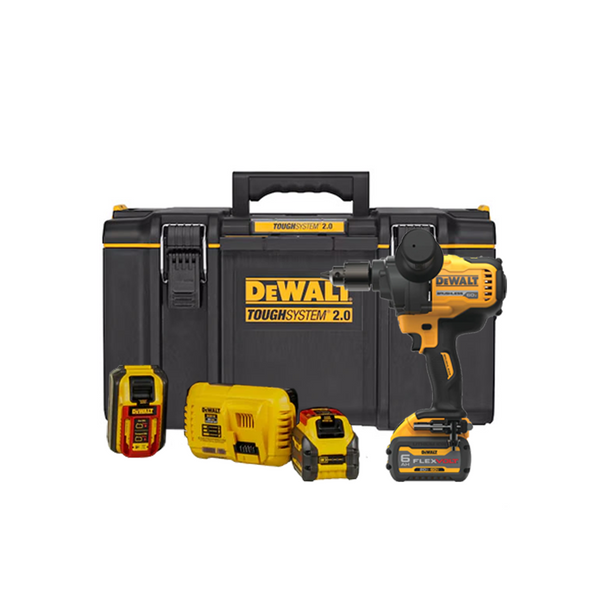
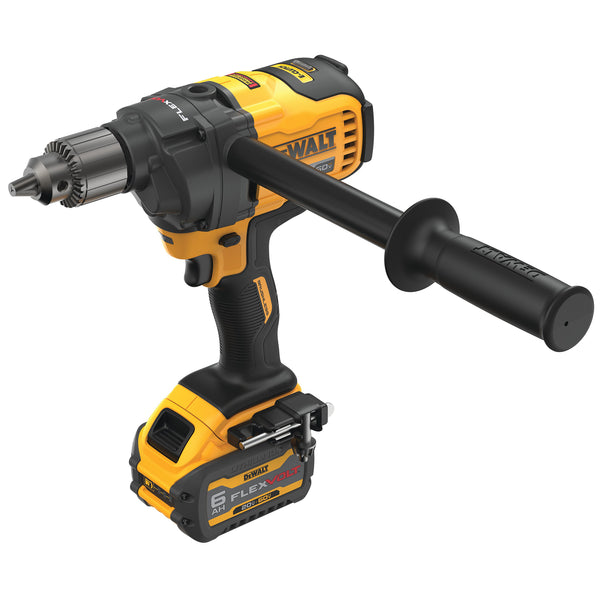
Landscape Drill
Bundle
$999.99
Landscape Drill Bundle
The powerful brushless motor of the DEWALT DCD130T1 60V MAX* Mixer/Drill With E-Clutch® allows the mixer to tackle demanding drilling applications. To improve control, the Mixer/Drill has the anti-rotation E-CLUTCH System. This feature senses the motion of the tool and shuts it down if necessary. This kit includes two extra DEWALT DCB609 9Ah batteries, plus a large DEWALT ToughSystem DS400 storage case to keep your drill, batteries, and charger all in one convenient location. FREE SHIPPING TODAY (US lower 48 states only).
[button text="See Full Details" url="/products/landscape-drill-bundle"]
How to Choose the Best Drill for Digging
At Power Planter, we’re dedicated to making the highest-quality augers to help you tackle tough gardening and landscaping jobs with ease. Choosing the best drill for auger bits that delivers enough strength to dig through your specific soil can play a significant role in the success of your gardening project.
If you’re looking for the best drill for planting, consider these factors:
- Power supply: A corded model means you don’t have to worry about running out of juice, but a cordless one gives you the ability to work anywhere on a property. Modern battery technology provides enough power for heavy digging. Always use a drill with an adjustable clutch.
- Speed: The more RPM the tool delivers, the less torque. This might make a difference when digging through dense soils, where torque is particularly important. Always use a tool with a slow setting or “drill mode” for the highest torque and least amount of kickback.
- Amperage: The higher the amperage, the more powerful the drill. If you’re using a longer bit, make sure you have enough strength to drive it. See our chart above.
- Variable speed:If the power tool you choose has variable speed, it can be very useful for augering around a property. That’s because variable speed allows you to control the amount of torque the motor produces.
- Reverse: Switching into reverse mode can be convenient for easily removing the auger from the hole you’ve just dug.
- Keyless chuck: This feature allows you to switch between augers quickly, if needed.
Still have Questions?
[button text="Contact Us" url="/pages/contact"]


